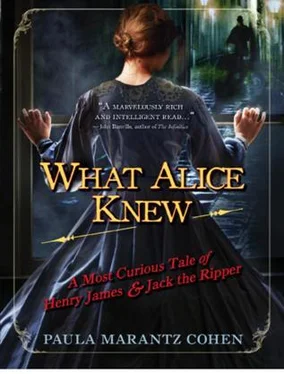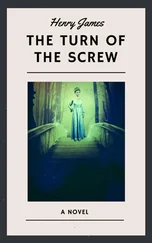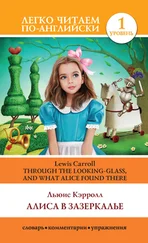She opened her eyes and looked at the picture. It was dark. She had heard he had a dark palette. In this case, he had painted her as though it were twilight. Much of her figure was blurred in the impressionist manner, but the head, though not in the style of high realism, had been delineated with a greater attention to detail. The face itself was pale and stood out against the dark background. The eyes were bright and hooded, and the mouth straight, but with the faintest touch of a smile. Her head was bare; he had painted the cap where he had thrown it to the right of the bed. The effect was of her having uncovered herself for the observer, if only in a slight way, but with a certain passionate determination.
“It’s an interesting portrait,” she noted ruminatively. “I look like one of those ecstatic saints or martyrs.” It was true that the frame of the bed might have been an altarpiece, and flecks of yellow used to highlight the dark background gave a suggestion of fire.
“Do you think I have made you look spiritual?” asked Sickert.
“You have made me look otherworldly,” said Alice.
“But you are otherworldly,” he insisted. “You are a woman beyond my reach.”
She laughed.
He had been looking at her as she looked at the painting, and Alice felt herself shiver slightly under his gaze. Neither one of them had noticed that Katherine had entered the room until she crossed over to seat herself in the chair next to the bed.
“And what do you think, Miss Loring?” said Sickert, with a trace of irritation in his voice.
“It’s not my place to say,” said Katherine in her usual mild tone. “It’s Alice’s portrait.”
“You don’t like it!”
Katherine shrugged. “We see the subject differently.”
“And how, pray tell, do you see her?” He asked the question automatically, as though not really wanting to know the answer.
“I see her as an island of reason in a world of irrationality, cruelty, and turmoil,” responded Katherine.
“An island of reason who lives her life as a professional invalid?”
“It’s how she pays for her rationality,” said Katherine quietly.
“And how do you think Mr. Sickert sees me?” Alice asked, intervening and addressing her companion.
“As a feral animal, caged,” said Katherine shortly.
“I thought he made me look like an ecstatic saint.”
“Perhaps it’s the same thing,” said Sickert. He turned quickly to Alice. “I’m sorry that I have not pleased your friend, but perhaps that is inevitable. One cannot please everyone.” His voice had grown distant, and he seemed to have become restless and less at ease.
“That’s true,” murmured Alice.
Sickert was not listening. He had reached for his hat. His impatience to be gone had become almost palpable. “I’m afraid I must bid you ladies good-bye.”
Alice looked at him, but he did not look at her. His eyes grazed the room, and a look bordering on disgust seemed to cross his features. Katherine had disturbed something. Or the portrait, being finished, had brought the disturbance. Whatever it was, Alice felt the bond between them had dissolved, leaving nothing but the painting behind. Perhaps it was at the root of his art—that the past held no meaning for him once the work was through; that his relationship to life was entirely a matter of impressions and observations as they occurred in the present. He had connected profoundly with her because she had consumed his imagination in the act of painting her, but the painting was done. She had become what ostensibly she had always been: an invalid spinster taking up his time. It was as though a spell had lifted.
But not just for him. Looking at him within the circle of Katherine’s cool gaze, she saw an arrogant stranger. What could she possibly know about this man’s character and motives? She felt herself blushing at the thought of what she had once felt. It was time, indeed, that he left.
“Thank you for the portrait,” she said, taking Katherine’s hand and leaning her head back on the pillow. “You should hurry, or you’ll miss your train.”
It’s a side of you,” said Henry. He was sitting at the little table in Alice’s bedroom, assessing the portrait and eating a scone with blueberry jam that Sally had made from her own recipe. William was expected. They had agreed to meet to discuss how they would proceed with the case, if indeed they would. The idea of more women being killed filled Alice with dread, but how could she, a bedridden invalid, really be of any use in hunting the killer?
“It was the Whistler connection that threw us,” said Alice. “It got us thinking in the wrong direction. You with your ‘ha ha.’”
“It was a normal sort of connection,” said Henry huffily. “I still say Whistler laughs that way.”
“We made too much of the ‘ P of W ,’” continued Alice. “It could stand for anything.”
“That’s true,” he agreed. “The Prince of Wales, for example.”
“Exactly,” said Alice. It was as likely as anything else.
“And it’s not as though Whistler didn’t have other pupils,” noted Henry. “Legros said he had a habit of taking the Slade’s leavings.”
“There you are,” said Alice.
Before they could say more, they heard the downstairs door open and the sound of footsteps coming upstairs. William had arrived.
He strode into the room and over to the bed and then bent down and kissed Alice on the cheek. They had been exaggeratedly affectionate to each other ever since his “mad scene,” as she secretly referred to it to herself. She had always believed she understood him better than anyone, better even than his wife, but his outburst had surprised her, causing her to conclude that she had missed something—or been kept in the dark. The fact discomfited her, but on the surface she behaved as though nothing had happened.
“What do you think?” she asked, motioning to the portrait as he seated himself on the other side of the bed.
He turned to look.
“Do you like it?”
He did not respond. He was studying the painting more closely than would have been expected, his brow furrowed. “What’s that doing there?” He pointed with sudden vehemence to the bonnet in the lower left of the painting.
“It’s my bonnet,” said Alice, peeved by his focus on a minor detail. Although the floor and the bed had been painted in the impressionist style, the bonnet was, like the face, delineated rather clearly. “It’s a joke,” she explained irritably. It did not seem very funny to her now. “I had expected he would paint me with it on, but he said he wanted to see my hair.” She touched the cap on her head, recalling the incident in which he had thrown the cap to the floor and put his hand to her head. “Why do you ask?”
William again did not respond, but his face was deep in concentration and then seemed to shape itself into a grimace. “Your friend Sickert…do you know where he is?”
“He’s off to Cornwall,” said Alice with a certain indifference. “This time I believe he means it.”
“He must be stopped.”
Alice looked at him quizzically.
“We have let a guilty man get away.” William’s voice was high with restrained emotion. “The bonnet”—he pointed to the canvas—“there was a cap on the floor in precisely that spot in Mary Kelly’s bedroom. It struck Abberline and me at the time as an odd sort of thing for a woman of that type to have lying about, but I wouldn’t have noted its position had I not just seen the photograph of the crime scene this morning. And I understand it now. None of the other murders were in a bedroom, with the victim in a nightdress. This was different because it was inspired by someone in particular.” He looked at his sister, who was staring at him uncomprehendingly. “Don’t you see? The killer placed the cap on the floor of Kelly’s room in an effort to re-create the scene in your bedroom. I hadn’t realized until now how similar that room was to yours. And Kelly was your age, considerably younger than the previous Ripper victims.”
Читать дальше












